Skeletal muscle bioenergetics during all-out exercise: mechanistic insight into the oxygen uptake slow component and neuromuscular fatigue
- PMID: 28209743
- PMCID: PMC5451539
- DOI: 10.1152/japplphysiol.01093.2016
Skeletal muscle bioenergetics during all-out exercise: mechanistic insight into the oxygen uptake slow component and neuromuscular fatigue
Abstract
Although all-out exercise protocols are commonly used, the physiological mechanisms underlying all-out exercise performance are still unclear, and an in-depth assessment of skeletal muscle bioenergetics is lacking. Therefore, phosphorus magnetic resonance spectroscopy (31P-MRS) was utilized to assess skeletal muscle bioenergetics during a 5-min all-out intermittent isometric knee-extensor protocol in eight healthy men. Metabolic perturbation, adenosine triphosphate (ATP) synthesis rates, ATP cost of contraction, and mitochondrial capacity were determined from intramuscular concentrations of phosphocreatine (PCr), inorganic phosphate (Pi), diprotonated phosphate ([Formula: see text]), and pH. Peripheral fatigue was determined by exercise-induced alterations in potentiated quadriceps twitch force (Qtw) evoked by supramaximal electrical femoral nerve stimulation. The oxidative ATP synthesis rate (ATPOX) attained and then maintained peak values throughout the protocol, despite an ~63% decrease in quadriceps maximal force production. ThusATPOX normalized to force production (ATPOX gain) significantly increased throughout the exercise (1st min: 0.02 ± 0.01, 5th min: 0.04 ± 0.01 mM·min-1·N-1), as did the ATP cost of contraction (1st min: 0.048 ± 0.019, 5th min: 0.052 ± 0.015 mM·min-1·N-1). Additionally, the pre- to postexercise change in Qtw (-52 ± 26%) was significantly correlated with the exercise-induced change in intramuscular pH (r = 0.75) and [Formula: see text] concentration (r = 0.77). In conclusion, the all-out exercise protocol utilized in the present study elicited a "slow component-like" increase in intramuscular ATPOX gain as well as a progressive increase in the phosphate cost of contraction. Furthermore, the development of peripheral fatigue was closely related to the perturbation of specific fatigue-inducing intramuscular factors (i.e., pH and [Formula: see text] concentration).NEW & NOTEWORTHY The physiological mechanisms and skeletal muscle bioenergetics underlying all-out exercise performance are unclear. This study revealed an increase in oxidative ATP synthesis rate gain and the ATP cost of contraction during all-out exercise. Furthermore, peripheral fatigue was related to the perturbation in pH and deprotonated phosphate ion. These findings support the concept that the oxygen uptake slow component arises from within active skeletal muscle and that skeletal muscle force generating capacity is linked to the intramuscular metabolic milieu.
Keywords: ATP cost; ATP synthesis; magnetic resonance spectroscopy; muscle metabolism; neuromuscular fatigue.
Figures
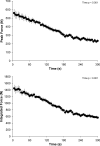
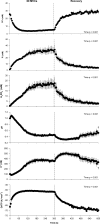
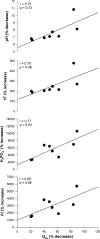
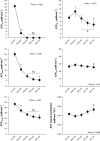

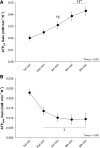
Similar articles
-
Oxidative ATP synthesis in human quadriceps declines during 4 minutes of maximal contractions.J Physiol. 2020 May;598(10):1847-1863. doi: 10.1113/JP279339. Epub 2020 Apr 1. J Physiol. 2020. PMID: 32045011
-
Bioenergetics and ATP Synthesis during Exercise: Role of Group III/IV Muscle Afferents.Med Sci Sports Exerc. 2017 Dec;49(12):2404-2413. doi: 10.1249/MSS.0000000000001391. Med Sci Sports Exerc. 2017. PMID: 28767527 Free PMC article.
-
On the role of skeletal muscle acidosis and inorganic phosphates as determinants of central and peripheral fatigue: A 31 P-MRS study.J Physiol. 2022 Jul;600(13):3069-3081. doi: 10.1113/JP283036. Epub 2022 Jun 2. J Physiol. 2022. PMID: 35593645 Free PMC article.
-
High-energy phosphate metabolism in the exercising muscle of patients with peripheral arterial disease.Vasa. 2008 Aug;37(3):199-210. doi: 10.1024/0301-1526.37.3.199. Vasa. 2008. PMID: 18690587 Review.
-
Energy system interaction and relative contribution during maximal exercise.Sports Med. 2001;31(10):725-41. doi: 10.2165/00007256-200131100-00003. Sports Med. 2001. PMID: 11547894 Review.
Cited by
-
Heart Rate Variability After Sprint Interval Training in Cyclists and Implications for Assessing Physical Fatigue.J Strength Cond Res. 2022 Feb 1;36(2):558-564. doi: 10.1519/JSC.0000000000003549. J Strength Cond Res. 2022. PMID: 32304516 Free PMC article.
-
Cellular and molecular contractile function in aged human skeletal muscle is altered by phosphate and acidosis and partially reversed with an ATP analog.Am J Physiol Cell Physiol. 2025 Apr 1;328(4):C1220-C1233. doi: 10.1152/ajpcell.00332.2024. Epub 2025 Mar 6. Am J Physiol Cell Physiol. 2025. PMID: 40047118 Free PMC article.
-
Influence of group III/IV muscle afferents on small muscle mass exercise performance: a bioenergetics perspective.J Physiol. 2018 Jun;596(12):2301-2314. doi: 10.1113/JP275817. Epub 2018 May 8. J Physiol. 2018. PMID: 29644702 Free PMC article.
-
Muscle microvascular oxygen delivery limitations during the contraction phase of intermittent maximal effort contractions.Eur J Appl Physiol. 2025 Feb;125(2):353-364. doi: 10.1007/s00421-024-05605-0. Epub 2024 Sep 10. Eur J Appl Physiol. 2025. PMID: 39251444
-
Exercise tolerance through severe and extreme intensity domains.Physiol Rep. 2019 Mar;7(5):e14014. doi: 10.14814/phy2.14014. Physiol Rep. 2019. PMID: 30825269 Free PMC article.
References
MeSH terms
Substances
Grants and funding
LinkOut - more resources
Full Text Sources
Other Literature Sources
Medical
Research Materials
Miscellaneous

